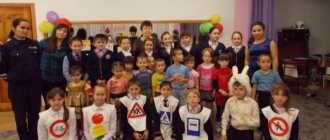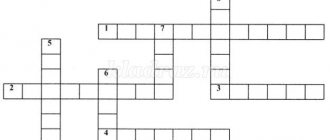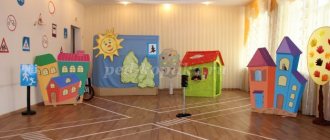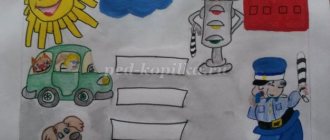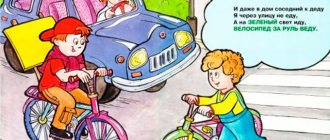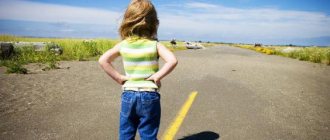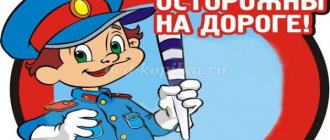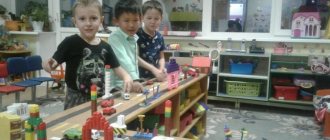Punch card “Pedestrian crossing”
Goal: To consolidate children’s knowledge about the rules for crossing the road at a pedestrian crossing, about the pedestrian traffic light and its signals.
Children's task: Color the circles opposite the picture. Use a red pencil if the children's actions in the picture are not correct, green - if the children's actions in the picture are correct. Explain why children’s actions are correct in some situations and incorrect in others.
Punch card “Pedestrian crossing”
Purpose: To clarify children’s knowledge about the rules for crossing the street, about the expected danger when crossing the road incorrectly. To consolidate children's knowledge about traffic lights and their signals.
Children's task: Use a pencil or felt-tip pen to draw a path for a man (in the form of an arrow) to correctly cross the road without getting hit by a car. And paint over the traffic light signal with the color of pencil that allows a little person to cross the road. Name the traffic lights and their designation. Explain why the little man will pass through this particular traffic light signal without incident, and in this particular place.
How to draw forest protection signs and signs prohibiting eating fly agaric?
The most important problem that is worth focusing on, first of all, is forest fires .
Here are the basic rules and signs that explain them:
1) You cannot make fires in the forest.
2) You cannot smoke in the forest and throw unextinguished cigarette butts on the ground.
3) You cannot burn dry grass.
There are also some general rules of conduct in the forest. Here are the rules and forest protection signs for them:
1) Do not break branches of bushes and trees.
2) You can’t destroy bird’s nests.
3) You cannot litter in the forest.
4) You cannot pick flowers, or catch butterflies and bees.
5) You must not harm the animals that live in the forest.
In addition, children should know that in the forest you can find poisonous plants and mushrooms that should not be touched.
Here is a sign prohibiting eating fly agaric:
There are a lot of signs that can be drawn for the environment, and the first sign that I would like all the guys to know is the sign prohibiting eating fly agarics:
And the second sign, which I am sure is also very important to know, is a sign prohibiting eating unknown plants and berries - look at this sign - there is a wolfberry drawn inside a red circle - very dangerous:
And one more important sign that says that you should not break tree branches:
Next, I placed many signs at once, from which you can choose the one you need - here is a sign about the ban on fires, and a sign about the ban on litter, and a sign that you cannot pick flowers, especially primroses and flowers that are in the Red Book, for example, a flower known to all of us as the lily of the valley.
Forest protection signs can be drawn this way: first you need to remember what is needed to protect the forest. Do not light a fire; if you light a fire with adults, be sure to extinguish it and fill it with water. Do not pick up chicks with your hands, do not make noise, do not litter. You should also not destroy nests, break branches, or cut down trees. Thus, we need to draw on the signs everything that cannot be done. For example, draw a fire or a bonfire in a red circle and cross it out. Draw a hand with garbage falling out of it and cross it out. We draw a sign in the same way: you can’t eat fly agarics. We draw a fly agaric and cross it out with a red line. For a sample, I have selected drawings of ready-made security signs for you.
Punch card "Road signs"
Purpose: To clarify children’s knowledge about road signs and their designation and types of road signs (prohibitory, directional, informational, warning).
Children's task: Draw opposite the plot picture the road sign that should be in this situation. Name the road sign and its purpose. Name the prohibiting, warning, informational or directional road sign.
Summary of a lesson on traffic rules in the middle group “Looking for road signs”
Summary of a lesson on traffic rules in the middle group “Looking for road signs”
Target
: introduce children to the rules of the road, rules of safe behavior on the street, road signs.
Tasks:
Clarify children's understanding of the street, intersection, roadway, sidewalk. Strengthen children's understanding of the purpose of traffic lights for cars and people. Reinforce knowledge of traffic lights for children. Learn to listen carefully to adults and each other, to answer questions. Develop coherent speech skills, attention, memory, intelligence. To cultivate goodwill, responsiveness, empathy, a desire to provide assistance, and the need to follow traffic rules.
Material
: street layout, slides of various situations on the road; puzzles with images of road signs, road signs
Preliminary work:
problem-search conversation: “Our friends on the road”; looking at pictures about road signs, traffic lights, transport.
Progress of the lesson:
Educator: Guys, I received an email today, shall we read it?
“Hello, dear guys!
Residents of the fairy-tale country “Traffic Light” are writing to you.
We lived in great friendship with road signs, followed all traffic rules, respected and listened to the main traffic light. Therefore, order and peace on the streets have always reigned in the country.
But suddenly an evil and powerful hurricane hit the country and took away all the road signs. And the country began to be in chaos.
Help us guys!
Educator: Guys, let's help the fairy-tale heroes?
Children: Yes!
Educator: We close our eyes, I say the magic words “CRIBLE, CRABLE, BOOM!”
(Look what happened in the city. (Children look at the model, discuss the emergency situation: there are no road signs, car accidents, the traffic light has disappeared.) Educator: - Yes, guys, there is no order in the city. The signs need to be rescued and returned to their place. That’s just how to do this? Children: we need to look for signs. Educator: The hurricane took the signs far away, we need to go. And to find out what we will go on, we need to guess the riddle:
- I’ll take you wherever you want, Just buy a ticket! The driver is sitting behind the wheel, And the engine is humming inside me, The headlights are round, like a globe - I call myself... (Bus)!
Educator: where should we get on the bus? Children: at the bus stop. Educator: how do we find a stop? Children: according to the sign, there is a picture of a bus there. Educator: Look, there’s some kind of sign here. Children: Bus stop location. Educator: here we found a sign, and here is our bus. But before we get on the bus, let’s remember what we know about the rules of conduct at the bus stop.
Let's play the game "Allowed-Forbidden"
• Play and jump at the bus stop... • Sit calmly at the bus stop and wait for the bus...
Move away from adults.....
Forgetting your things at a bus stop...
• Behave calmly on the bus... • Give up your seat to older people... • Lean out of the window... • Respect traffic rules... Educator: quickly take your seats. “And while you and I are traveling, we will solve riddles.”
I'm so brilliant and, of course, lightweight. Along the road I rush like an arrow - You won’t be able to keep up with me! I have a steering wheel and tires, What is my name?... (Car)!
It has two wheels and a saddle on a frame. There are two pedals below, you spin them with your feet.
(Bike)
Doors, windows, but not a house. There are even seats in it. The headlights shine like eyes, there are four wheels. Dust swirls from underneath them. What's this?…
(Automobile)
And we have fun in our family
- Celebrating housewarming!
We moved in a jiffy!
And he helped us...
(Truck)
Transport sleeps sweetly at night to deliver in the morning. Everyone rushes to work, to kindergarten, to school in the morning. Only I can stay awake, wait for late passengers. Just dial the number, it will give you a ride... (taxi)
Educator: stop. We get off the bus. We are on the street. Slide show (city street).
Educator: look and tell me what you see? Children: there are a lot of cars here, people are walking. Educator: Every street has a roadway. What do you think it is for? Children: cars drive on this part of the street. Educator: - That's right, the roadway is needed for the movement of cars. There are special paths on both sides of the roadway. What are their names? Children: - Sidewalks. Educator: - What are sidewalks for? (Children's answers). Educator: - Absolutely right, for people. Adults and children walk along the sidewalk. Is that why they are called? Children: - Pedestrians. Educator: look, the Tanya doll is coming towards us. She's very sad. Let's ask what happened to her.
Doll Tanya: I was playing with the ball and it rolled onto the roadway. Show a slide (a girl runs out onto the roadway, chasing a ball).
Educator: That's right, guys, you can't play near the road, otherwise an accident might happen.
. Slide show.
(The boy is not sitting in a child seat and is not wearing a seat belt). Children: you must ride with a seat belt in the car, and do not get out of the car before adults.
Educator: That’s right, in the car children should sit in a child seat, fastened with seat belts and not get out before adults, and everyone should get out only when the car stops. Show a slide (a boy runs across the road in the wrong place).
Educator: - What if you need to cross the roadway? Where can this be done? Educator: - Yes, guys, you need to cross the road in special places called pedestrian crossings. How do you recognize this place? (Children's answers). Educator: - Correct! There is a sign “Pedestrian crossing” and white stripes are painted. First they look to the left, when they reach the middle, they look to the right. Educator: Tanya, go to the doctor and promise not to break traffic rules again. And we will go further by car.
Physical exercise “Machines” (STAND IN SAME ROW)
I'm rocking, flying at full speed (the children are walking) I am the driver myself (they imitate steering the steering wheel) And I myself am the motor (circular movements with my shoulders) I press the pedal (they bend the leg at the knee) And the car rushes into the distance. (running in place)
Educator: - Well done for everyone following the traffic rules! That's why we reached the forest so quickly. Educator: And here are the missing signs. The teacher puts up a tree on which signs hang: “Pedestrian crossing”, “Children!”, “Traffic light regulation”, Traffic light. Children explain the signs.
Collect puzzles-signs (split into pairs)
Educator: - Why do we need a traffic light? Children: to avoid accidents on the roads. Educator: - That's right, guys! A traffic light helps regulate traffic and establishes order on the streets. Educator: Do you know that the colors at the traffic lights are....? Children: three. Educator: Now let’s check how well you know what each traffic light means? Red light? Children: Stop, it's dangerous! The path is closed! Educator: - Yellow. Children: - Warning! Wait for the signal to move! Educator: Does the light say green? Children: - The way is open for cars! Outdoor game "Traffic Light"
We're going to play
Well, who should start?
One two Three,
You're starting!
Educator: - Do you think these road signs are needed in the forest? (Children's answers). Educator: - Why? (Children's answers). Educator: - That's right, guys! Road signs are not needed in the forest, because there are no streets or vehicles. They need to be returned to the city and put in their places. Let's take road signs and traffic lights, get into the cars. Go!
Let's put all the signs in the city in their place. (Children arrange and explain the signs)
Now there is order in the fairy-tale town and all the residents are happy.
Educator: - Because you are so kind, sympathetic, attentive and know the rules of the road well, you are rewarded with coloring books.
